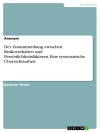The lack of practical information available to the families of vulnerable individuals – and sometimes a similar lack of resources for the professionals who deal with them – can lead to frustration and in some cases tragedy. In this practical guide for anyone involved in caring for patients with challenging behaviour, Gráinne Smith (author of the bestselling Anorexia and Bulimia in the Family) champions the importance of teamwork so that carers, both formal and informal, can learn to collaborate in treatment approaches with professionals. Drawing on anonymous case studies as well as recent research and experience, this unique book provides an array of practical tools and templates to aid the development of consistent, effective all-round care for vulnerable individuals.
Table des matières
Foreword by Janet Treasure.
Preface.
Acknowledgements.
Introduction.
1 Families are fascinating.
2 Families coping.
3 Back to basics.
4 Consequences.
5 Friends and family.
6 Lies, manipulation and control freakery.
7 Difficult scenes and destructive relationships.
8 Resources: creating 24-hour best care.
9 Professionals and carers: pressures, problems and
pleasures.
10 Confidentiality: a thorny issue.
11 More assumptions, perceptions and interpretations.
12 Constructive professional-carer conversations.
13 Challenging the behaviour.
14 Communications in difficult days.
15 Actively helping carers cope.
16 Put on your own mask first.
A final word.
Appendix.
References and bibliography.
Index.
A propos de l’auteur
Grainne Smith is a former Head Teacher, based in North East Scotland. When her daughter developed anorexia and bulimia nervosa, Grainne became her main carer, and wrote Anorexia and Bulimia in the Family (published by Wiley in 2004) about her experiences to help other carers. Since then she has spoken about the role of carers and families at a number of professional conferences, and has collaborated with academics and practitioners on various eating disorders initiatives, including preparing a CD-ROM for use by professionals and families.












